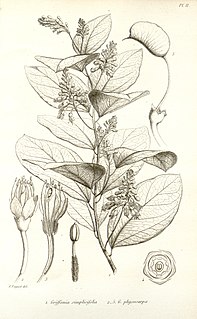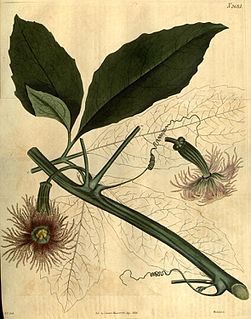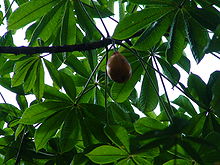
Matteuccia is a genus of ferns with one species: Matteuccia struthiopteris. The species epithet struthiopteris comes from Ancient Greek words στρουθίων (strouthíōn) "ostrich" and πτερίς (pterís) "fern".

Carica is a genus of flowering plants in the family Caricaceae including C. papaya, the papaya, a widely cultivated fruit tree native to the American tropics.

Cocculus is a genus of 11 species of woody vines and shrubs, native to warm temperate to tropical regions of North America, Asia and Africa. The common name moonseed is also used for the closely related genus Menispermum.

Baccaurea is a genus of flowering plant belonging to the family Phyllanthaceae. The genus comprises over 100 species, distributed from Indomalesia to the West Pacific. It is dioecious, with male and female flowers on separate plants. Many species contain edible fruits.

Dillenia is a genus of flowering plants in the family Dilleniaceae, native to tropical and subtropical regions of southern Asia, Australasia, and the Indian Ocean islands.

The Caricaceae are a family of flowering plants in the order Brassicales, found primarily in tropical regions of Central and South America and Africa. They are usually short-lived evergreen pachycaul shrubs or small to medium-sized trees growing to 5–10 m tall. One species, Vasconcellea horovitziana is a liana and the three species of the genus Jarilla are herbs. Some species, such as the papaya, bear edible fruit and produce papain.

Orania is a genus of the palm tree family Arecaceae, and includes flowering plants native to Southeast Asia, Madagascar, and New Guinea.
Perebea is a genus of plant in family Moraceae.

Pteris vittata, commonly known variously as the Chinese brake, Chinese ladder brake, or simply ladder brake, is a fern species in the Pteridoideae subfamily of the Pteridaceae. It is indigenous to Asia, southern Europe, tropical Africa and Australia. The type specimen was collected in China by Pehr Osbeck.

Griffonia is a genus of flowering plants in the legume family, Fabaceae. It belongs to the subfamily Cercidoideae. Griffonia is known to have a high concentration of 5-HTP in its seeds.
Desmostachya is a genus of grass in the family Poaceae.
Monelytrum is a monotypic genus of grass in the family Poaceae. Its sole species, Monelytrum luederitzianum is endemic to Namibia. Both common and scientific names were named for the city of Lüderitz, located in the far south of Namibia.

Trema orientale is a species of flowering tree in the hemp family, Cannabaceae. It is known by many common names, including charcoal-tree, Indian charcoal-tree, pigeon wood, Oriental trema, and in Hawaii, where it has become naturalized, gunpowder tree, or nalita. It has a near universal distribution in tropical and warm temperate parts of the Old World, with a range extending from South Africa, through the Middle East, the Indian subcontinent and southern China to Southeast Asia and Australia.
Jensenia spinosa is a dioicous bryophyte plant in the liverwort family Pallaviciniaceae. It is the only African member of the genus Jensenia, and generally occurs at high elevations. It is widespread but scarce, and has been found in South Africa, Malawi, Tanzania, Rwanda, the Democratic Republic of the Congo, as well as the islands of Mauritius, Réunion and Saint Helena.

Vitis vulpina is a North American species of herbaceous perennial vines in the grape family. It is widespread across most of the eastern and central United States as well as the Canadian Province of Ontario.
Castilleja beldingii is a species of hemiparasitic plant in the broomrape family, formerly the only species in the genus Clevelandia, it was moved to the genus Castilleja, the 'indian paintbrushes', in 2009.

Telfairia pedata, commonly known as oysternut, queen's nut, Zanzibar oilvine, kweme or kulekula, is a dioecious African liana which can grow up to 30 metres long, having purple-pink fringed flowers, and very large, many-seeded, drooping, ellipsoid berries which can weigh up to 15 kg. It is valuable for having edible fruit, seeds and oil.
Jedda is a monotypic plant genus in the Thymelaeaceae family, its only species being Jedda multicaulis. The species is an upright, evergreen bush indigenous to tropical Australia, discovered in the early 1980s on the Cape York Peninsula in northern Queensland, in an area of grassy forest land. The full extent of its distribution is unknown. The name Jedda is a toponym from Jedda Creek, which is close to where the type specimen was collected from.

Vella is a genus of plants in the family Brassicaceae, under which there are no fewer than six species. Species are many branched, and have hairy, sessile, entire leaves that are narrower in width at their bases, widening out to form ovals. Fruits are stiff follicles. Vella is endemic to that area of land encompassing Algeria, Morocco, and Spain.

Jacaratia spinosa is a species of tree, in the genus Jacaratia of the family Caricaceae. It is found in the tropical dry forests of central and southern Mexico, Nicaragua, and El Salvador. Its stem is used as a main ingredient in the manufacturing of candy. Its fruit is also appreciated by many animals including monkeys and birds.













